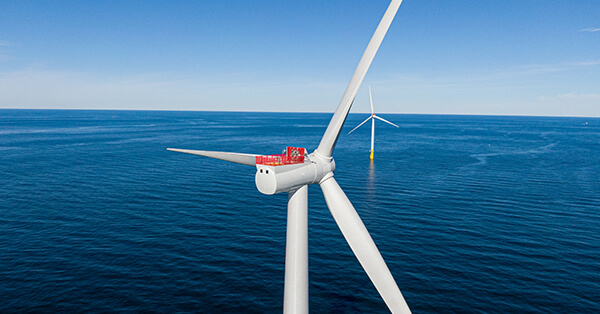Campaigners already mounting federal court challenges to wind energy projects off Massachusetts and New Jersey are assessing their chances against the Coastal Virginia Offshore Wind project, Dominion Energy’s ambitious plan for a 2.6-gigawatt array that is the largest planned to date in U.S. waters.
The Heartland Institute, a free-market and libertarian group allied closely with fossil fuel companies, announced along with groups Committee For A Constructive Tomorrow (CFACT), and the American Coalition for Ocean Protection that they are hiring a legal firm to “explore a lawsuit protecting the right whale from Dominion Energy’s efforts to place an offshore wind project directly in their habitat off the coast of Virginia.”
Founded in 1984, the Heartland Institute campaigns against calls for reducing fossil fuel use, arguing that “alarmist climate models” overstate the effects of human carbon emissions on the Earth’s climate. The group has worked with opponents of wind developers with federal leases off Maryland and Virginia from the Bureau of Ocean Energy Management.
City officials and resort interests in Ocean City, Md., are fighting Dominion’s wind power plans over fears that turbines, even faintly visible from miles offshore, could ruin their tourist trade.
Offshore wind critics with similar concerns in other seaside resort areas of southern New England and New Jersey have also raised questions about whether wind power development would affect the highly endangered North Atlantic right whale population.
The Heartland plan plans to bring those objections to Virginia.
“Unless BOEM requires extensive, effective, unprecedented protection measures for the North Atlantic right whale immediately, this species is almost certainly headed toward extinction,” said David Stevenson, president of the American Coalition for Ocean Protection.
“With only a little more than 300 individual right whales alive today, this endangered species is in dire need of protection, and the Virginia Wind Project lies directly in their annual migration path. The project will require extensive daily maintenance by multiple service ships, and the potential for whale fatalities due to ship strikes is indisputable.”
Stevenson is director for energy and environmental policy at the Caesar Rodney Institute, a Delaware-based libertarian non-profit group, which has advocated for offshore oil drilling in the Mid-Atlantic. It was an early entrant against Vineyard Wind, filing court action on behalf of a Nantucket resident.
With the whale population now estimated at only around 340 animals, protecting the survivors is a priority for the National Oceanic and Atmospheric Administration, under pressure from federal court rulings and environmental groups.
Northeast lobster fishermen must change their gear and stay out of restricted areas under the new protection measures, and NOAA is being pushed to enforce vessel speed limits when right whales are on the move. The agency’s recent proposal to extend 10-knot speed limits to vessels less than 65 feet long is raising alarm among ferry and charter and party fishing boat operators on the East Coast.
The Heartland-led group hopes to turn that ferment against wind development. It says the law firm Gatzke, Dillon and Ballance of Carlsbad, Calif., “has worked with residents of Nantucket, Mass., and Long Beach Island, N.J., to represent them in evaluating the upcoming draft environmental impact statement which the Bureau of Ocean Energy Management is producing for the Coastal Virginia Offshore Energy Project.”
The Nantucket group’s lawsuit against BOEM is in federal court in Massachusetts while the New Jersey action is in federal court in the District of Columbia.
“We are not only very concerned about the future of the right whale, which extensively uses the ocean waters affected by the wind-power project, but also concerned as to how BOEM will address the fact that this project, despite its alleged benefits regarding carbon dioxide and climate change, will actually cause the release of more carbon dioxide into the atmosphere than it will consume,” said Craig Rucker of the Committee for a Constructive Tomorrow.
“The Virginia Wind Project is a risky, costly, waste of resources and a pitiful way to generate electricity for a state which claims to be business and consumer friendly,” said Heartland president James Taylor. “Before construction commences, the project should be given the same level of scrutiny for environmental protection by the courts and the federal authorities as has been provided for fossil fuel projects in Virginia, such as the Mountain Valley Pipeline.”
BOEM and the National Oceanic and Atmospheric Administration are paying close attention to the potential for conflicts over right whales. NOAA’s National Marine Fisheries Service in 2021 documented overlaps of right whale habitat use with wind energy leases off southern New England.
“Monitoring and mitigation plans (for offshore wind projects) should include protocols for the likely presence of right whales throughout the year,” the NMFS study reported in August 2021.
“Their increasing summer and fall presence deserves special attention since this will overlap with the current schedule for pile driving for turbine foundations in the next few years, the phase of construction considered to have the greatest acoustic impact, which could potentially affect right whale behavior,” according to the paper. “Management and mitigation procedures should be adapted and reevaluated continually in relation to right whales' use of the area.”
In 2019 the Vineyard Wind developers agreed with environmental groups to curtail construction in their lease area during winter and early spring when right whales are in the area.
At-sea monitors will watch for the approach of whales to make sure construction activity stops when whales are nearby. Compressed air “bubble curtains” around turbine construction sites will dampen sound that can affect the whales’ behavior and communication.
In June 2022 offshore wind developers Ørsted and Eversource announced a similar agreement with environmental groups for right whales during construction and operation of the South Fork Wind project of Long Island’s east end.
They promise a 10-knot vessel speed limit for all boats working on the project, “unless an effective adaptive speed management plan is in place,” according to the developers.







